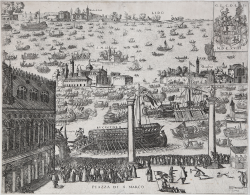- New




| Reference: | A50369 |
| Author | Giovanni TEMINI |
| Year: | 1618 |
| Zone: | Venice |
| Printed: | Venice |
| Measures: | 450 x 350 mm |



| Reference: | A50369 |
| Author | Giovanni TEMINI |
| Year: | 1618 |
| Zone: | Venice |
| Printed: | Venice |
| Measures: | 450 x 350 mm |
A true rarity of Venice — the only known first-state example.
This finely executed engraving by Giovanni Temini, dated 1618, vividly captures the grandeur of the Sposalizio del Mare or “Marriage of the Sea,” one of the most iconic ceremonies of the Venetian Republic.
The print commemorates the Festa della Sensa (Feast of the Ascension)—a civic and religious festival held each year on Ascension Day, during which the Doge of Venice sailed aboard the lavish Bucintoro, the state galley, to the mouth of the port at San Nicolò del Lido. There, in a ritual symbolizing Venice’s dominion over the sea, he would cast a gold ring into the Adriatic while pronouncing, “Desponsamus te, mare” (“We wed thee, sea”), reaffirming the city’s sacred and political bond with the waters that ensured its prosperity.
Temini’s etching offers a dynamic, dual perspective of the ceremony, depicting both the departure from Piazza San Marco and the arrival at the Lido, encapsulating the pageantry and spectacle of the event. The dense flotilla of noble and popular vessels shown surrounding the Bucintoro underscores the broad civic participation and festive spirit that characterized the occasion. The scene is rendered with notable clarity and movement, though, as later critics observed, Temini appears unfamiliar with Venetian rowing technique: the oars in his vessels are improbably placed on the same side, which would have rendered the boats unsteerable—a humorous anachronism noted by Venetian scholars.
This engraving serves as a valuable historical record of Venice’s enduring relationship with the sea—an expression of civic identity, religious symbolism, and political ritual that anchored the Republic’s maritime power in both image and ceremony.
This first state of the print, marked by the signature “Gio: Temini forma” in the lower right corner and the coat of arms of Doge Antonio Priuli (elected in 1618) in the upper right, is considered exceptionally rare. Later states, printed by Stefano Scolari, altered the date to 1623, replaced the artist’s name with “In Venetia,” and introduced compositional changes, including the addition of a standing figure in the foreground. These later states are also extremely rare; we know of only on other offered for sale in the past 25 years.
Giovanni Temini was an Italian engraver active during the early 17th century, particularly around 1622. His work is associated with the Baroque period, and he is known for his engravings that often drew inspiration from prominent artists of his time.
A fine impression, printed with tone on contemporary lai paper, trimmed at the plate mark, small loss restored along the central lower edge, overall in excellent condition.
Giovanni TEMINI (attivo tra il 1620 e il 1650)
|
Giovanni Temini was an Italian engraver active during the early 17th century, particularly around 1622. His work is associated with the Baroque period, and he is known for his engravings that often drew inspiration from prominent artists of his time.
|
Giovanni TEMINI (attivo tra il 1620 e il 1650)
|
Giovanni Temini was an Italian engraver active during the early 17th century, particularly around 1622. His work is associated with the Baroque period, and he is known for his engravings that often drew inspiration from prominent artists of his time.
|